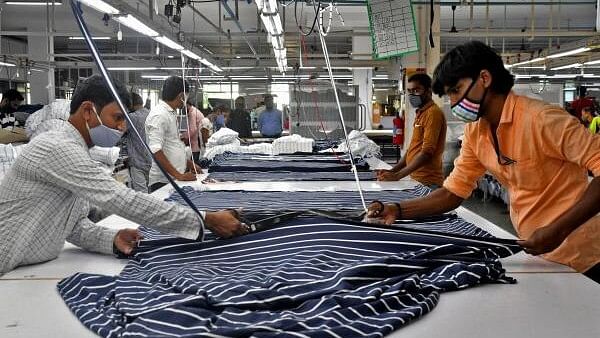
Garment workers cut fabric to make shirts at a textile factory of Texport Industries in Hindupur.
Credit: Reuters
On June 4, the results of the ongoing general elections will be known, and India will soon have a new government at the Centre. One of the most pressing tasks for this new government will be implementing a new industrial policy that addresses current structural constraints, and reimagines India’s manufacturing sector in the context of global supply chain shifts and the green agenda for climate change.
While the target for the share of manufacturing in India’s gross value added (GVA) has been set at 25 per cent, this has remained fairly steady averaging 17.7 per cent since 2011-2012, with a compound annual growth in real terms of 5.63 per cent over the last 13 years. There is, therefore, much to be done to raise growth and value in manufacturing. For this, the industrial policy will have to tie in with other spheres such as trade, labour, logistics, small businesses, regulatory compliances etc. to provide an enabling environment for firms to flourish.
While the manufacturing sector overall has recovered from the Covid-19 pandemic, the Production-Linked Incentive (PLI) scheme announced in 2020 has not quite met its expected performance — actual investments for the period April-December 2023 came in at around ₹306.95 billion — 61.8 per cent of the target. A sectoral review of the scheme should be on the cards, to check if the aim of raising capabilities and scale is coming through in each of the 14 sectors picked under the scheme.
On the export front, despite the government’s strong intent, India has not managed to tap deep into the opportunities opening with the West moving away from China. Merchandise export performance has been lacklustre, standing at $437.06 billion in FY2024 compared to $451.07 billion in FY2023. For long-term impact, a relook at India’s tariff duties, trade pacts, logistics and infrastructure vis-à-vis competitors on a sector-by-sector basis is necessary.
However, a national industrial policy cannot focus only on raising investment and output. While manufacturing productivity should be raised through technological intervention, the government also must balance the need for absorbing workforce shifting from agriculture and other activities. The ILO’s India Employment Report 2024 has called for a push for labour-intensive manufacturing and also greater efforts at skilling. The recommendations include more focus on micro, small and medium enterprises (MSMEs) through a decentralised approach.
This brings us to the bulk of the manufacturing sector, residing in small enterprises, which lack the skills to upgrade technology or scale, and are, as the ILO report points out, heavily constrained by local policies and regulatory environment in which they operate. Much has been written about the regulatory cholesterol that curtails the growth of businesses in general, and small firms in particular. A National Compliance Mission as suggested by Gautam Chikermane can clean out the redundant and duplication in compliances under various Acts such as the Factories Act, the Electricity Act, etc.
The environment for doing business in India can be quite hostile as the ORF report ‘Jailed for Doing Business’ pointed out; of the 69,233 compliances businesses must follow, 37.8 per cent carry imprisonment clauses. While India’s rank in the World Banks’ Ease of Doing Business (EoDB) has improved significantly from 142 in 2014 to 63 in 2020, relooking the compliance burden would go a long way in making India a more attractive investment destination.
Another component of the EoDB ranking is enforcing contracts, where India stands low at 163 in 2020: it takes 1,445 days to resolve a dispute in Mumbai, compared to 120 days in the region’s best performer Singapore. The fact that enforcing contracts remains such a challenge shows up in the long-pending issue of delayed payments, the bane of MSME existence.
GAME (Global Alliance for Mass Entrepreneurship) estimated Rs 10.7 trillion in 2020-2021, around 7 per cent of GVA, to be payments that are delayed beyond the 45-day deadline mandated by the MSME Act. About 80 per cent of this amount is outstanding to micro and small businesses, which are already capital-starved. Unfortunately, the asymmetry of power between the small suppliers and large buyers shows up in the smaller firms bearing cash-flow disruption, despite measures such as Samadhan and TReDS.
This year, Section 43B(h) of the Income Tax Act kicked in allowing larger firms to claim deductions against payments done to the MSMEs only after actual payment was made. However, instead of ushering in better compliance, big firms are reportedly moving orders from registered MSMEs to informal ones, leading to small businesses cancelling their Udyam registrations. Which just gets to show that in the absence of a culture of contract enforceability, additional measures do not yield the intended results. The MSME ministry should host stakeholder consultations to find an appropriate solution, which could include amending the MSME Act.
All said and done, manufacturing in India has immense potential that remains to be unleashed, and the next government must get cracking on multiple fronts to make India a global manufacturing hub.
(This article is the first in a series of articles on the challenges and opportunities before the next Union government.)
(Sumita Kale, CEO and Senior Fellow, Indicus Foundation.)
Disclaimer: The views expressed above are the author's own. They do not necessarily reflect the views of DH.